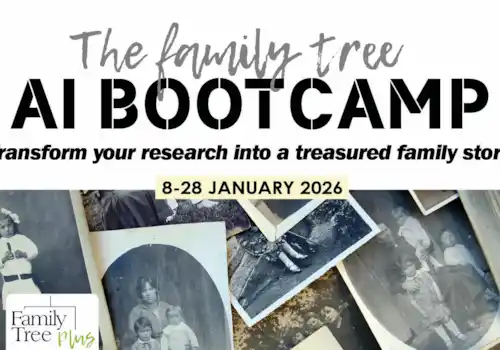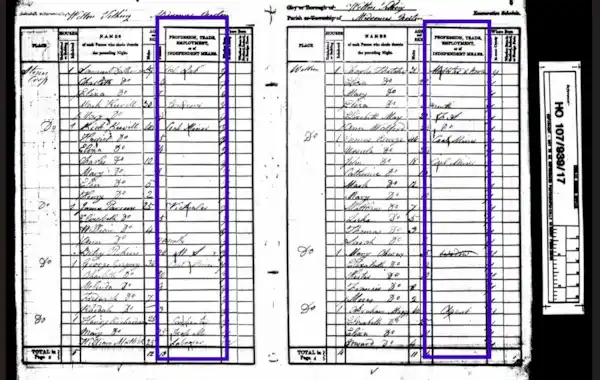Discover how to find your ancestors' occupations, where to look for family history occupation records, and what those old job titles mean. This guide covers records to help you trace ancestors' Victorian occupations. Plus learn about researching old jobs in the early 20th century, and back to the 18th century and before too.
Quick links:
- About tracing ancestors' old occupations in the Victorian period
- Where to find Victorian ancestor occupation records
- What did your ancestor do for a living?
- How to start researching ancestors' occupations
- Understanding old job titles in genealogy
- Did people have a job for life in the past?
- How to trace an apprentice
- How to trace ancestors in business and company records
- Trace ancestors' working rights
- How to trace Victorian ancestors using trade directories
- What were the top occupations in the 1921 Census?
- Discover unusual ancestor occupations from times gone by
- How to use local history to research trades and industries
About tracing ancestors' old occupations in the Victorian period
The Victorian period is one of the most fruitful eras of family history research. Because of this, even if you are relatively new to genealogy research, you will be able to find details of your Victorian ancestors' occupations.
Details of their jobs, trades and professions are very often included, particularly for the men in the core record collections of the 1800s - namely birth, marriage and death records, parish registers and of course the census.
Add to the mix, the vast collections of digitised newspapers and increasingly detailed trade directories, and the Victorian period can provide a rewarding period to search for details of ancestor clues.
Note too that it was during the Victorian period that many of our ancestors migrated from rural to urban areas, leaving their lives and work in the countryside, to instead find work in the rapidly growing industrial centres.
Of course, the Victorian era, 1700s and 1900s were periods during which many of our ancestors would have worked at sea and also served in the armed forces. See our separate guides for specific information to these lines of work.
Where to find Victorian ancestor occupation records
Search the census for ancestors' jobs
When searching the census records for details of your ancestors be sure to note their occupations. For many of our ancestors' details of their job title will be included.
In addition to noting your ancestors' occupation, note the job details for other people recorded nearby in the census records too. What were other members of the family doing? Were the children employed? What lines of work did the neighbours have? Answers to these questions will provide you with a richer understanding of their lives.
The census is particularly useful for tracing ancestors' occupations through the Victorian period and beyond, because it is available, decennially (ie for every 10 years) from 1841 right through to 1921 for England, Wales and Scotland.
For Ireland use the 1901 and 1911 Census records that are available.
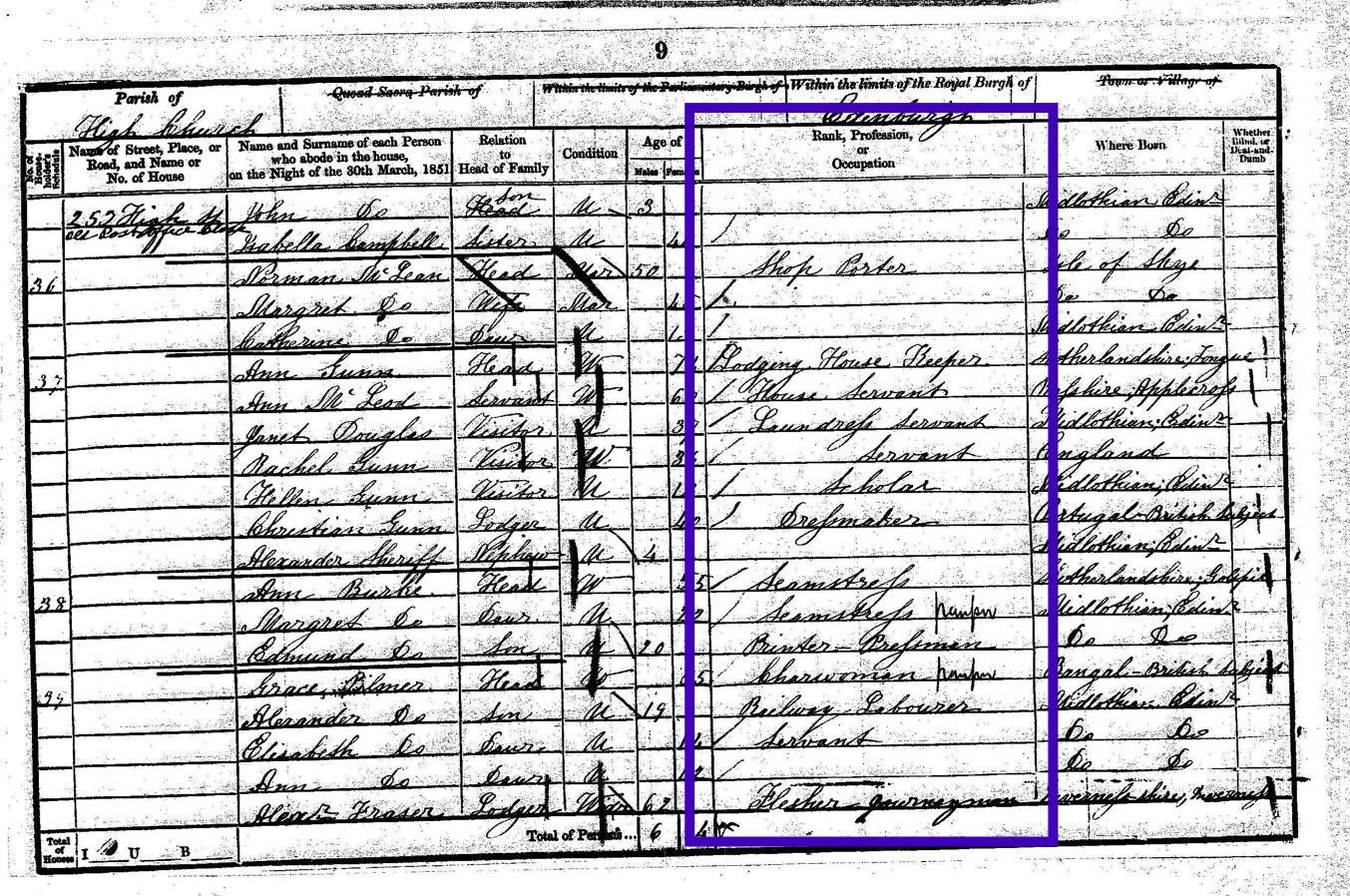
The census is fascinating to search for ancestor old occupation clues as it gives insights to what the neighbours did too. What can these details tell you about the locality?
Search the BMDs & parish registers for ancestors' jobs
Other records to help you trace the old occupations of Victorian ancestors include: the birth, marriage and death records (BMDs), and parish registers. Very often it is just the occupations of the fathers that are included. Again these records - the BMDs - are so useful for tracing occupations through the Victorian period, as the records have been kept from 1837 (England and Wales), 1855 (Scotland) and 1864 (Ireland).
They are also useful, going on into and through the 1900s, providing details of ancestor occupations in the records of birth, marriage and death through the 20th century. For the 18th century, parish registers would be the next best fit though details of occupation are included far less frequently as we research back in time.

Be sure to note the occupations of the fathers' of the bride and groom when studying marriage certificates, not just the occupation for the groom, and bride if given
Look more widely for details of Victorian ancestors' jobs
Explore the newspapers for details of your Victorian ancestors' occupations. From advertisements for a business they may own, or have worked for; to details of industrial accidents that may have occurred, newspapers are a valuable place to look. Many are now digitised, primarily at the British Newspaper Archive and also at Findmypast.
Search archive catalogues for details of Victorian ancestors' old industries
When doing family history, very often it is in the specific details that we find the clues we seek. Once you have worked out your ancestors' line of work from, for instance, the census, then explore the online catalogues of archives, to see if they hold collections of interest. You may wish to look at archives in the locality near to where your ancestor worked; or you may like to look for specific archives.
Heavy industries such as mining, and factory work, for instance, are renowned for the terrible accidents that sometimes occurred. See also the free online searchable index to Dr Mike Esbester's Railway Work Life & Death Project - of great interest if you have Victorian and early 20th century ancestors who worked on the railway in some capacity.
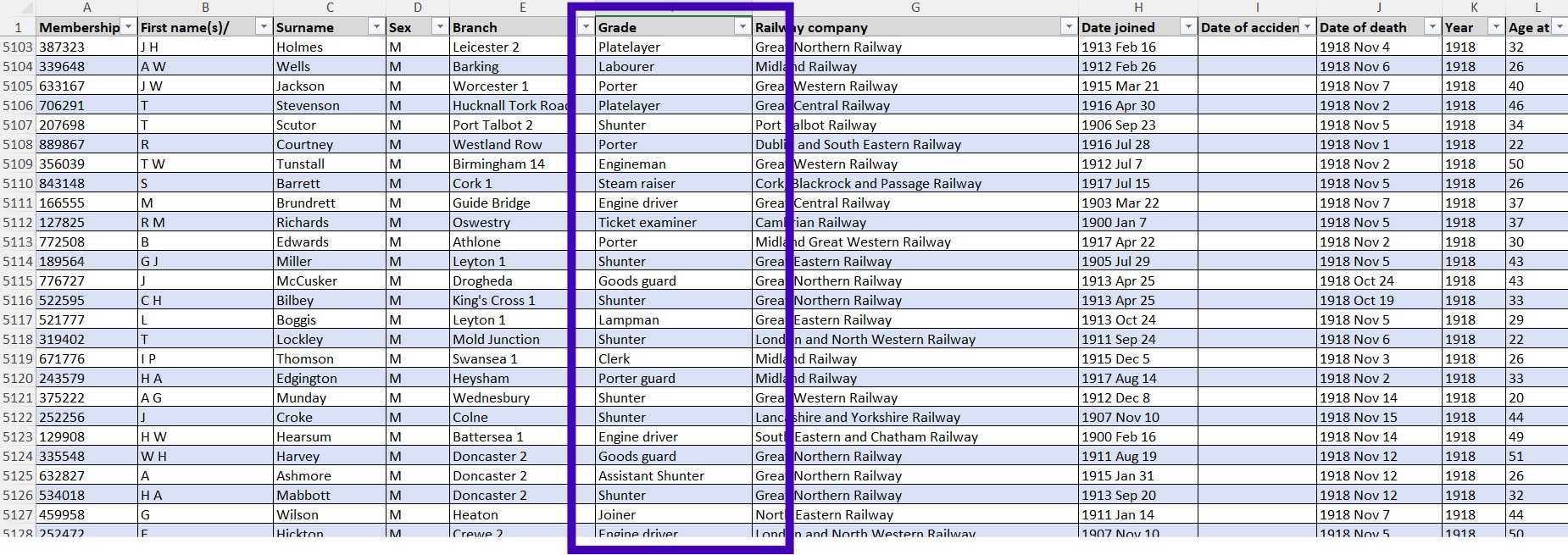
Don't worry if this example above isn't particularly legible - you may download the entire Excel, free of charge from the RWLD Project web page
What did your ancestor do for a living?
Genealogist, speaker, author and researcher Chris Paton writes:
'When studying our ancestors’ lives, many of the vital records that we use to reconstruct their genealogical relationships to one another will usually also yield information on occupations. Investigating what our ancestors did for a living can help to inform us of their world views, and to understand many of the decisions they took in life.
'The details gleaned can often include what they earned, where they chose to live, how they knew other people, and even what their political affiliations might have been.'
How to start researching ancestors' occupations
Chris Paton: 'Many resources are available to help flesh out the stories.
- The National Archives (TNA) offers research guides to some key occupations with databases and links to externally held collections, while additional records can be found on the subscription-based platforms.
- A catalogue search on Ancestry.co.uk can help to locate useful collections.
- Findmypast.co.uk has records in several categories, such as ‘Churches & Religion’, ‘Education & Work’, ‘Military, Armed Forces and Conflict’, ‘Directories and Social History’ and ‘Institutions & Organisations’.
- Most resources of interest in TheGenealogist.co.uk will be found within its ‘Occupational Records’ category, and in its ‘Military Records’ section.'
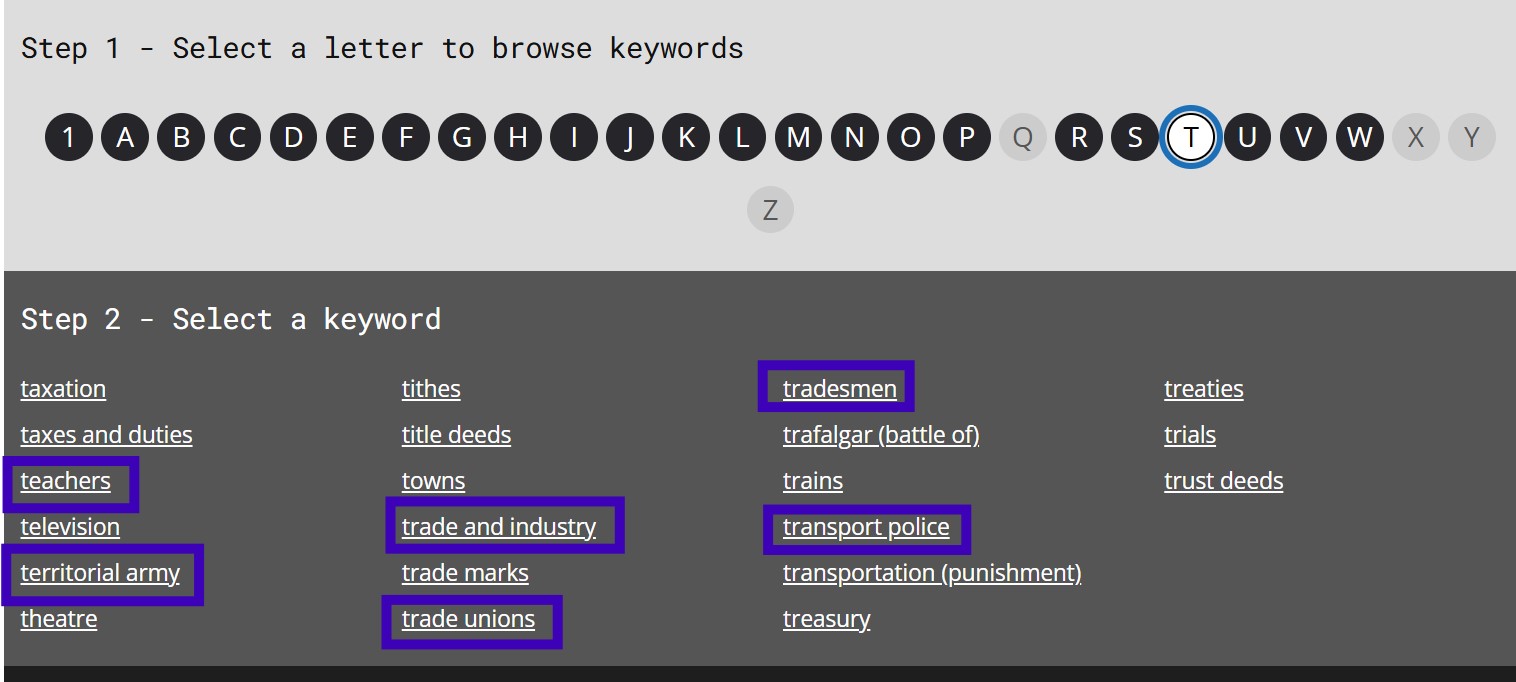
Browse the research guides at The National Archives to get help specific to your ancestor-occupation needs. Highlighted here are just a few of the numerous guides that would be helpful for tracing different lines of work from teachers to tradesmen, transport police and more.
Understanding old job titles in genealogy
Chris Paton: 'If a term presents itself that needs a definition, consult:
Did people have a job for life in the past?
Chris Paton: 'It is worth bearing in mind that occupations could change as people got older, and that our ancestors may even have had more than one job; a salmon fisherman could only fish for salmon when the fish courteously appeared in the relevant rivers, and would likely have had alternative employment in off-season periods.
'We also need to take into account that the descriptions of some of our ancestors in records such as the censuses may well have been inflated, or indeed hidden. Great-great-grandfather Jimmy might have described himself in the census as an officer on a ship, when he was in fact a stoker in the engine room, while wee Mavis may well have been using a term such as ‘dressmaker’ to describe a career making dresses, or perhaps as a euphemism for a much older profession.'
How to trace an apprentice - researching ancestors' work
Chris Paton: 'For many people, a trade was something that was trained for through the apprenticeship process.
'Following an apprenticeship to a master of usually around seven years in length, a tradesman could work as a self-employed journeyman, putting himself out for work a day at a time, and could later progress to become a master tradesman himself.
'In the 18th century masters within trade guilds and incorporations had to pay a stamp duty upon the completion of their apprentices’ indenture periods. Such payments can be found within TheGenealogist’s ‘Apprenticeship Records’ dataset, in Ancestry’s ‘UK, Register of Duties Paid for Apprentices’ Indentures, 1710-1811’ database, or on Findmypast under ‘Britain, Country Apprentices 1710-180’.
'Additional apprenticeship collections can also be found on the latter two sites, and many other record sets will be found in local archives – use TNA’s Discovery catalogue to locate them in UK repositories, particularly for England and Wales.
See also: 'The National Records of Scotland hosted catalogues at for records in Scotland and the PRONI catalogue for Northern Irish holdings.'
How to trace ancestors in business & company records for family history
Search the Gazette for historic businesses
Chris Paton: 'For those working in business, the London Gazette and its Scottish and Irish equivalents in Edinburgh, Dublin, and Belfast can help to locate news of promotions, notices for bankruptcies, mergers, start-ups and wind-ups, and more. The London, Edinburgh and Belfast editions are available freely at https://www.thegazette.co.uk while historic editions of the Dublin Gazette from 1750-1810 can be found through the Irish Parliament’s Oireachtas Library website.
Search old newspapers for ancestor-business clues
Chris Paton: 'More generally, newspapers can also provide excellent contextual information on firms, and even on named individuals within them. The British Newspaper Archive (also at Findmypast) has more than 94 million pages of content from across Britain and Ireland'
See also: The Irish Newspaper Archives and the free Welsh Newspapers Online equally valuable as resources.
Check Companies House for historic business records
Chris Paton: 'The firm that your ancestor may have worked for, or indeed even created, might still be trading and hold employment and other records. If so, it should be registered at Companies House.
'Some larger businesses and corporations may well have established their own archives, with good examples including the M&S Company Archive and the Hong Kong and Shanghai Banking Corporation.
Check local, national and specialist archives for historic company records
Chris Paton: 'Other companies, including those that no longer trade or do business, might have deposited their historic collections with local archives.
- An excellent resource for the capital, for example, is the London Metropolitan Archives guide to business records holdings available
- The Scottish Business Archive at the University of Glasgow is also well worth consulting.
- Smaller firms might also have helpfully had their historic holdings catalogued by external archives, which may well be worth the effort to visit. Check TNA Discovery catalogue, and that of the National Register of Archives for Scotland (NRAS) for potential holdings and locations.'
Tracing ancestors in the mining industry or on the move
Remember your ancestor may have migrated for work
Chris Paton: 'Your ancestor might have been a mobile worker, such as a navvie, shipyard worker or miner, and if so, it is entirely possible that he and his family may have moved great distances – something to be aware of when consulting the censuses and vital records.'
Tip - remember to look for ancestors working across the globe: We are an island nation so many of our coastal ancestors had maritime occupations. The Maritime History Archive – though based in Newfoundland, Canada – has lots of British resources including a crew agreements database for 1857-1942 and an online catalogue.
Trace ancestors' working rights & Trade Union history
Chris Paton: 'Many of our ancestors in the labouring occupations have struggled for over two centuries to secure decent employee rights, and to be able to unionise and to work ‘in combination’ to have their interests represented.
'In many instances the fight for better rights became entangled with the fight for democracy itself. Mark Crail’s Chartist Ancestors website explores the history of the mid-19th century Chartist movement, and includes lists of names, trials, uprisings and more.
'The Working Class Movement Library covers many of the great strikes and campaigns, and lists holding within its archives at Salford.
'TUC History Online provides a trade union history timeline covering many industries over the last two centuries as well as specialist sections on the General Strike of 1926, the Match Girls strike of 1888, the Workers at War project and more. The Trade Union Ancestors site, also run by Mark Crail, has similar offerings.'
The excerpts above were first published in Chris Paton's article on old occupations in the March 2019 issue of Family Tree magazine. You can buy a digital copy here.
If you have yet to explore your ancestral occupations, it’s time to get to work!
How to trace Victorian ancestors' using trade directories
Author, the late Dr Simon Wills: 'Trade directories can be extremely valuable for discovering what your ancestor did for a living and where they were based. The first British trade directory dates from 1677 and covers London merchants, but it was in the later 18th century that directories started to become more well-established and common, and in the 19th century they flourished.'
Search free online trade directories for:
England and Wales, 1760s-1910s at the University of Leicester Special Collections
and Scotland, 1774-1911 at the National Library of Scotland website
For Ireland visit John Grenham's website, which contains leads to digitised trade directories for Ireland, some of which are freely accessible.
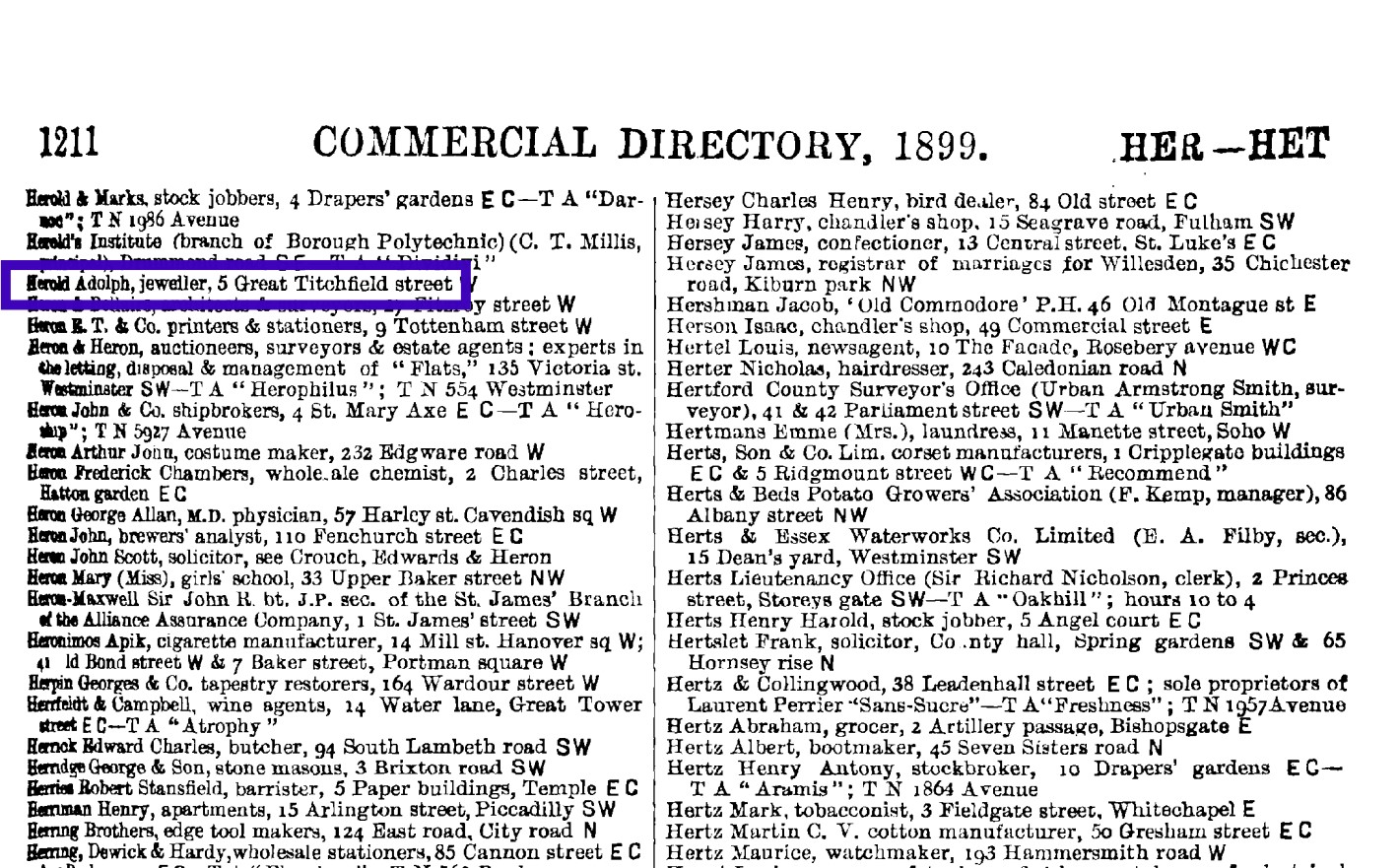
This example Post Directory for London from the late 19th century shows Victorian business proprietors, listed by surname, with their line of work and the address for their business premises. Use trade directories to trace between between the census, to work out the years in operation for an ancestor's business, and to find the address they were working out of too of course!.The importance of trade directories in the early 1800s
Dr Simon Wills: 'The earliest publications often simply listed inhabitants of a community by name and profession, with an address or a parish where they could be found. However, this is particularly useful information in the period before the first census in 1841. It may be the only way to determine what your ancestor did for a living.'
Who is listed in trade directories?
Dr Simon Wills:
- 'Not all workers are identified in early trade directories. Generally, the people named are of two types. The first are ‘upstanding members of the community’ – lawyers, schoolmasters, clergymen, physicians and so forth.
- The second type are people who owned or rented business premises. So, for example, you may discover named cobblers, butchers, and blacksmiths but not the individuals who worked for them.
- You won’t find persons who did not trade from a fixed address such as hawkers, peddlers, and fishwives. Most people who did relatively menial jobs or worked from their own homes are also usually omitted, including charwomen, labourers, weavers, and nurses.
- The street directories that appeared in Victorian times identified a broader range of inhabitants if they were householders.'
Find unusual details of old occupations in trade directories
Dr Simon Wills: 'Trade directories may provide all sorts of useful additional information that you didn’t expect to find. Sometimes an entry will state when the business was founded, or give a brief description of the services provided.
'In the Sheffield directory for 1857, James Turner states that his company was founded in 1789 and produced ‘wire fencing, and ornamental wire work for parks and gardens, also riddles, screens, fenders, bird cages, window blinds etc’. It’s also common in the 19th century to find businesses run by partners with each person named. Sometimes these are family members.'
The excerpts above were first published in Dr Simon Wills' guide to trade directories in the August 2021 issue of Family Tree magazine. You can buy a digital copy here.
What were the top occupations in the 1921 Census?
1921 Census report and statistics courtesy FindMyPast/The UK National Archives.
For women, the most frequently occurring occupations recorded in the 1921 Census for England and Wales were:
- 1. Private Personal Service e.g., domestic servant
- 2. Cotton Manufacture
- 3. Local Government
- 4. Dealing in Textiles, Drapery, and Clothing
- 5. Dress and Blouse Making
For men, the lines of work most often recorded in the 1921 Census for England and Wales were:
- 1. Coal mining
- 2. Agriculture
- 3. Building & Contracting
- 4. Central Civil Government & Defence
- 5. Railway Transport
Access the 1921 Census for England and Wales at FindMyPast and Ancestry - for the 1921 Census for Scotland see ScotlandsPeople.
Discover unusual ancestor occupations from times gone by
Ancestry delved into the historic records to highlight some of the quirkier or niche professions from the past 150 years – from sin-eaters and hop stringers to knocker-uppers and walking stick benders.
For example, the role of knocker-uppers, otherwise known as ‘human alarm clocks’, was to wake people up so the occupants inside could get to work on time. Early bird William Crompton from Bolton was one of the eldest recorded knocker-uppers and would rise at 3.45am to wake factory workers every morning, for a fee of up to sixpence. How did Mr Crompton wake up? Good question! By an alarm clock.
- What about a 'sin-eater'?
At late as the 19th century, your ancestor could have had the ominous role of a sin-eater, hired to stand over the deceased and take his or her sins as their own. The last sin eater was said to be Richard Munslowfrom Shropshire, who died in 1906.
- Or a hop-stringer?
Until technology advanced in the 1900s, it used to be the job of men on stilts to prepare the lines of poles in fields, to allow hop vines to grow.
- A walking stick bender?
Before the aid of machines, there were human walking stick benders.
- Clock winder?
A clock winder did exactly that — wind clocks. Before electric clock winders and technology came into play, people would be responsible for keeping time manually
- Whalebone cutter?
Thanks to its lightness, strength, elasticity and flexibility, whalebone (which isn’t actual bone but baleen used to filter food) was once used in making corsets, brushes, buggy whips and umbrellas.
- Lamplighter?
A profession associated with the late 1800s and early 1900s, their role was to light the town’s street lamps.
- Almond sorter?
This job, which involved removing any foreign bodies or impure kernels from almond stock in factories, was predominantly undertaken by women.
Simon Pearce, family history expert at Ancestry said: “With the impact of technological developments and cultural changes over the past couple of centuries, many of the roles our ancestors may have held are no longer in existence. But these jobs – and the lives of our family members who did them – can come to life when you look through historic records and photos.
"Through them, you can piece together who your ancestors were and the lives they led. Historic occupation records often contain a lot of information - including when and where they were appointed to that role, any qualifications they held and, in some cases, disciplinary action against them.’’
How to use local history to research trades & industries
Discover bygone local industries
Discover bygone local industries. Discover how you can track down clues to help you find out a wealth of information on the principal trades that once thrived in your area.
Look at old buildings for clues about local industries
Explore your street and the surrounding area for clues. These could range from the obvious – such as on old flour mill or a blacksmith’s anvil – to more subtle clues such as hook above a doorway (perhaps used to haul sacks onto the upper floor) or a three-storey dwelling (sometimes indicating that the upper floor was used by the family for weaving).
These initial clues, combined with the points below, should allow you to fine-tune your research and decide where to look next.
Study street and house names for clues to local work
Even modern areas can yield clues in terms of street and house names, with such places often named after old trades, even on new-build estates. If you think you’ve found such a clue, get hold of old maps of the local area and you might find evidence of a farm, mill, workshop or shop that point to an earlier use of the area.
Think about the location and the impact on local trades
Your location is often a big clue when it comes to local trades and industries. A harbour town is sure to have had a fishing industry (and associated trades) and if you live in a region known for textiles or mining, for example, local museums may have examples of items used in these trades, and perhaps even photos of craftspeople at work.
Even within the last century, a number of trades have died out as the world has changed – people like blacksmiths, chimney sweeps, farriers, weavers and thatchers now possess rare skills that once would have been fairly commonplace.
Watch vintage footage of craftspeople at work
For film collections showing craftspeople at work, try Scottish Screen Archive and the British Film Industry archive.
Blog last updated 12 August 2025.
Get more family history advice with the Family Tree newsletter
Sign up to receive the Family Tree newsletter and we'll send you a friendly, informative weekly email packed with expert tips, advice and special offers. As a welcome gift we'll also send you a resource kit featuring interview sheets, family tree charts and more!



